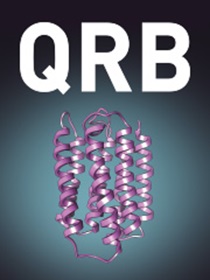Thermal protein unfolding by differential scanning calorimetry and circular dichroism spectroscopy Two-state model versus sequential unfolding
IF 7.2
2区 生物学
Q1 BIOPHYSICS
引用次数: 47
Abstract
Abstract Thermally-induced protein unfolding is commonly described with the two-state model. This model assumes only two types of protein molecules in solution, the native (N) and the denatured, unfolded (U) protein. In reality, protein unfolding is a multistep process, even if intermediate states are only sparsely populated. As an alternative approach we explore the Zimm–Bragg theory, originally developed for the α-helix-to-random coil transition of synthetic polypeptides. The theory includes intermediate structures with concentrations determined by the cooperativity of the unfolding reaction. We illustrate the differences between the two-state model and the Zimm–Bragg theory with measurements of apolipoprotein A-1 and lysozyme by differential scanning calorimetry (DSC) and CD spectroscopy. Nine further protein examples are taken from the literature. The Zimm–Bragg theory provides a perfect fit of the calorimetric unfolding transitions for all proteins investigated. In contrast, the transition curves and enthalpies predicted by the two-state model differ considerably from the experimental results. Apolipoprotein A-1 is ~50% α-helical at ambient temperature and its unfolding follows the classical α-helix-to-random coil equilibrium. The unfolding of proteins with little α-helix content, such as lysozyme, can also be analyzed with the Zimm–Bragg theory by introducing the concept of ‘folded’ and ‘unfolded’ peptide units assuming an average unfolding enthalpy per peptide unit. DSC is the method of choice to measure the unfolding enthalpy, $\Delta H_{\rm exp} ^0 $, but CD spectroscopy in combination with the two-state model is often used to deduce the unfolding enthalpy. This can lead to erroneous result. Not only are different enthalpies required to describe the CD and DSC transition curves but these values deviate distinctly from the experimental result. In contrast, the Zimm–Bragg theory predicts the DSC and CD unfolding transitions with the same set of parameters.差示扫描量热法和圆二色光谱的热蛋白展开
热诱导蛋白展开通常用双态模型来描述。该模型假设溶液中只有两种类型的蛋白质分子,天然(N)和变性,未折叠(U)蛋白质。实际上,蛋白质的展开是一个多步骤的过程,即使中间状态只是稀疏分布的。作为一种替代方法,我们探索了Zimm-Bragg理论,该理论最初是为合成多肽的α-螺旋到随机线圈的转变而开发的。该理论包括中间结构,其浓度由展开反应的协同性决定。我们通过差示扫描量热法(DSC)和CD光谱法测量载脂蛋白A-1和溶菌酶来说明两态模型和Zimm-Bragg理论之间的差异。另外9个蛋白质的例子取自文献。齐姆-布拉格理论为所研究的所有蛋白质的量热展开转变提供了完美的拟合。相比之下,两态模型预测的跃迁曲线和焓值与实验结果有很大差异。载脂蛋白A-1在室温下约50%呈α-螺旋状,其展开遵循经典的α-螺旋-随机线圈平衡。α-螺旋含量较低的蛋白质(如溶菌酶)的展开也可以用Zimm-Bragg理论进行分析,方法是引入“折叠”和“未折叠”肽单元的概念,假设每个肽单元的平均展开焓。DSC是测量展开焓的首选方法,$\Delta H_{\rm exp} ^0 $,但CD光谱通常与两态模型相结合来推断展开焓。这可能导致错误的结果。不仅需要不同的焓值来描述CD和DSC的转变曲线,而且这些值明显偏离实验结果。相反,齐姆-布拉格理论预测DSC和CD展开跃迁具有相同的一组参数。
本文章由计算机程序翻译,如有差异,请以英文原文为准。
求助全文
约1分钟内获得全文
求助全文
来源期刊

Quarterly Reviews of Biophysics
生物-生物物理
CiteScore
12.90
自引率
1.60%
发文量
16
期刊介绍:
Quarterly Reviews of Biophysics covers the field of experimental and computational biophysics. Experimental biophysics span across different physics-based measurements such as optical microscopy, super-resolution imaging, electron microscopy, X-ray and neutron diffraction, spectroscopy, calorimetry, thermodynamics and their integrated uses. Computational biophysics includes theory, simulations, bioinformatics and system analysis. These biophysical methodologies are used to discover the structure, function and physiology of biological systems in varying complexities from cells, organelles, membranes, protein-nucleic acid complexes, molecular machines to molecules. The majority of reviews published are invited from authors who have made significant contributions to the field, who give critical, readable and sometimes controversial accounts of recent progress and problems in their specialty. The journal has long-standing, worldwide reputation, demonstrated by its high ranking in the ISI Science Citation Index, as a forum for general and specialized communication between biophysicists working in different areas. Thematic issues are occasionally published.
 求助内容:
求助内容: 应助结果提醒方式:
应助结果提醒方式:


